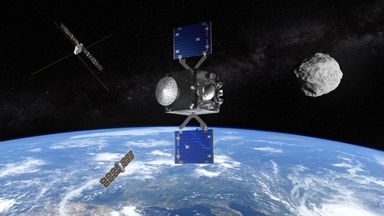A massive sunspot on the surface of the sun is moving toward a prime position where any explosion could shower Earth with protons.
The enormous sunspot, named AR3738, has a volatile 'beta-gamma-delta' magnetic field that is set to send out explosions of solar plasma as coronal mass ejections or flashes of radiation as solar flares.
When the sunspot reaches the "danger zone," protons from the sunspot's activities could be accelerated toward our planet by a phenomenon called the Parker spiral, possibly impacting Earth's satellites.
A proton storm, also known as a solar proton event (SPE), occurs when the sun emits a significant burst of energetic protons. These protons, which are positively charged particles, are accelerated to high velocities by solar flares or coronal mass ejections, and travel along the Parker spiral toward the Earth.
The Parker spiral is a model that describes the shape of the sun's magnetic field as it extends through the solar system. As the Sun rotates—once every 27 days or so—it twists its magnetic field lines into a spiral shape. This means that proton storms are ferried along the path of the spiral, and can race toward Earth if released from the right position on the sun's surface.
When these high-energy protons reach the Earth's magnetosphere, they are funneled towards the planet's poles, which can have several effects.
One possible impact of a proton storm is damage to satellite electronics, which can lead to communication disruptions and the malfunctioning of navigation and weather satellites.
Additionally, proton storms can pose a significant radiation hazard to astronauts in space, especially those outside of the Earth's protective magnetosphere, and can also affect passengers and crew on high-altitude polar flights, as these regions are more easily exposed to solar radiation.
On Earth, proton storms can interfere with electrical currents in power lines, potentially leading to power grid failures, and also impeded high-frequency radio communication and cause radio blackouts. When the energetic particles interact with the Earth's atmosphere, they can also produce spectacular auroras.
If the sunspot doesn't explode in the next couple of days, it will then move out of the danger zone and Earth will be in the clear.
The same sunspot released an X1.2-class solar flare on July 14, which caused a radio blackout over Australia, southeast Asia, and Japan. An X1.9-class flare was just released on July 16.
Do you have a tip on a science story that Newsweek should be covering? Do you have a question about sunspots? Let us know via science@newsweek.com.
Disclaimer: The copyright of this article belongs to the original author. Reposting this article is solely for the purpose of information dissemination and does not constitute any investment advice. If there is any infringement, please contact us immediately. We will make corrections or deletions as necessary. Thank you.



